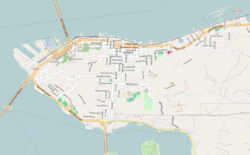
Astoria is a port city and the seat of Clatsop County, Oregon, United States. Founded in 1811, Astoria is the oldest city in the state of Oregon and was the first American settlement west of the Rocky Mountains. The county is the northwest corner of Oregon, and Astoria is located on the south shore of the Columbia River, where the river flows into the Pacific Ocean. The city is named for John Jacob Astor, an investor and entrepreneur from New York City, whose American Fur Company founded Fort Astoria at the site and established a monopoly in the fur trade in the early nineteenth century. Astoria was incorporated by the Oregon Legislative Assembly on October 20, 1876.

The Columbia River Maritime Museum is a museum of maritime history in the northwest United States, located about ten miles (16 km) southeast of the mouth of the Columbia River in Astoria, Oregon.
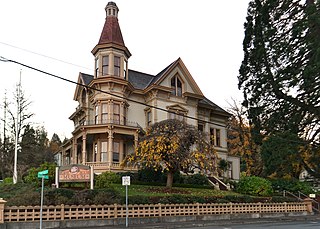
The Captain George Flavel House Museum known also as Capt. George Flavel House and Carriage House or the Flavel Mansion, is now a house museum in Astoria, Oregon, United States. It was built in 1885 in the Queen Anne architectural style, by George Flavel, a Columbia River bar pilot who was one of the area's first millionaires.

The George C. and Winona Flavel House is a house built in 1879 in Astoria, Oregon. It was listed on the National Register of Historic Places in 1991.
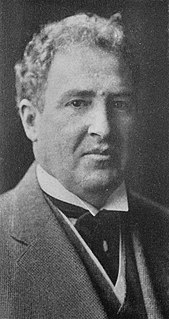
John Virginius Bennes was an American architect who designed numerous buildings throughout the state of Oregon, particularly in Baker City and Portland. In Baker City he did an extensive redesign of the Geiser Grand Hotel, designed several homes, and a now-demolished Elks building. He moved to Portland in 1907 and continued practicing there until 1942.

Emil Schacht was a prominent architect in Portland, Oregon. Schacht's work was prolific from the 1890s until World War I and he produced commercial buildings including factories and warehouses as well as residential projects, hotels and theatres. He is known for his craftsman architecture stlyle homes and was a founding member of the 1902 Portland Association of architects.

Morris Homans Whitehouse was an American architect whose work included the design of the Gus Solomon United States Courthouse in Portland, Oregon.
Job Ross House at 817 Exchange Street is a historic house in Astoria in the U.S. state of Oregon. The house was built by Job Ross about 1860. The one-and-half story home was also known as Klamath House and is not listed on the National Register of Historic Places. The address of the house was 361 Astor using the street names in force until the late 1890s. Then it became 361 Exchange, until the change in numbering in the 1955, when it assumed its current number. Job Ross lived in the house until his death on April 11, 1895, and his son George W. Ross lived there in 1896.
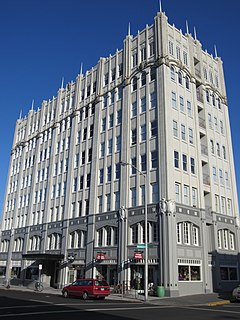
The John Jacob Astor Hotel, originally known as the Hotel Astoria, is a historic former hotel building located in Astoria, Oregon, United States, and listed on the National Register of Historic Places (NRHP). It is one of the tallest buildings on the Oregon Coast and is a "prominent landmark" in Astoria. Constructed in 1922–23, the hotel opened in 1924 and initially was the city's social and business hub, but soon was beset with a variety of problems, and struggled financially for years. It was renamed the John Jacob Astor Hotel in 1951, but a decline in business continued, as did other problems. The building was condemned by the city for safety violations in 1968 and sat vacant for several years until 1984, when work to renovate it and convert it for apartments began. It reopened as an apartment building in 1986, with the lowermost two floors reserved for commercial use. The building was listed on the NRHP in 1979. The world's first cable television system was set up in 1948 using an antenna on the roof of the Hotel Astoria.

The Old Astoria City Hall, now known as the Clatsop County Historical Society Heritage Museum, is a historic building located in Astoria, Oregon, United States, that is listed on the National Register of Historic Places. The building served as the city hall of Astoria from 1905 until 1939. It was the first location of the Columbia River Maritime Museum, from 1963 to 1982, and has been the Heritage Museum since 1985.
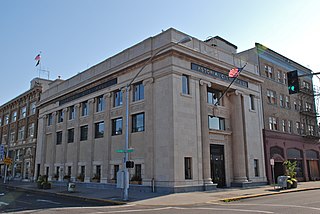
Astoria City Hall is the current city hall for the town of Astoria, Oregon, United States. Built in 1923 to house a bank, the building became the city hall in 1939, and it has remained Astoria's seat of government for more than 75 years.

Captain George Edward Flavel was an Irish American maritime pilot and entrepreneur. Born in 1823 to Irish parents, Flavel relocated to the West coast of the United States in 1849, working as a tugboat operator between Sacramento and San Francisco, California. In 1851, he settled in the northern coastal port city of Astoria, Oregon, where he became one of the first licensed bar pilots in the state.

C.H. Wheeler was a schooner-rigged unpowered lumber barge that operated during the year 1901, making only a few voyages before it was wrecked near Yaquina Bay with the loss of one life. C.H. Wheeler was the largest vessel up to that time to reach Tillamook City and the first vessel to transport a load of lumber from Tillamook to San Francisco. The circumstances of the loss of the C.H. Wheeler were controversial and resulted in the arrest of the captain of the tug that had been towing the barge before it was wrecked.
W.H. Harrison was a steam schooner that operated from 1890 to 1905 on the coast of Oregon, the lower Columbia River, and southwest Washington state. At that time the salmon cannery industry was one of the major businesses of the coast. W.H. Harrison, while also carrying passengers and transporting general freight and lumber, was one of a number of steamers supplying materials to canneries along the coast, and transporting cases of canned salmon from the canneries.

George R. Vosburg was a steam tug that operated from 1900 to 1912 on the Columbia River and the north coast of Oregon south from Astoria to the Nehalem River and Tillamook City. Generally called the Vosburg in practice, and referred to as Geo. R. Vosburg in official records, this vessel performed many tasks, from carrying cargo and passengers, and towing barges of rock for jetty construction. After 1925, this vessel was renamed George M. Brown, and was converted to diesel power. Under the name George M. Brown, this vessel remained in service until 1968 or later.
Carl W. Leick was an architect who worked in the Northwest of the United States. He designed structures for 25 sites on the West Coast, including the Turn Point (1893), Patos (1908), and Lime Kiln (1914) lighthouses.

Governor Newell was a sternwheel-driven steamboat that operated from 1883 to 1902 in the Pacific Northwest.
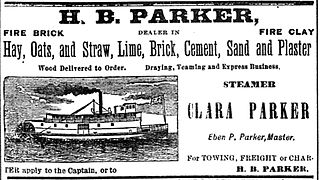
Clara Parker was a sternwheel-driven steamboat which was operated on the lower Columbia and lower Willamette rivers in the 1880s. The steamer ran for about ten years out of Astoria, Oregon in towing and jobbing work. In 1890 Clara Parker was rebuilt and renamed Astorian.
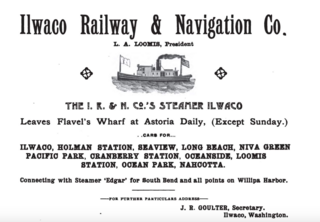
Ilwaco was a small riverine and coastal steamship built in 1890 which was operated as a passenger vessel for the Ilwaco Railway and Navigation Company, and later served in other roles, including tow and freight boat, cannery tender and fish packing vessel. Ilwaco was originally named Suomi.

The Callendar Navigation Company, sometimes seen as the Callendar Transportation Company, started in business in the early 1900s. Callendar was formed in the early 1900s, and was based in Astoria, Oregon. Callender was to become one of six large towing companies of the Columbia and Willamette rivers in the early decades of the 1900s, the others being Shaver Transportation, Smith Transportation, Hosford, Knappton Towing Co., and Willamette and Columbia River Towing Co. In 1922, Callendar Navigation merged with Knappton Towboat Co., which existed, with a name change in 1990, and which became part of Foss Marine in 1993.

